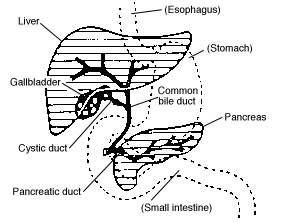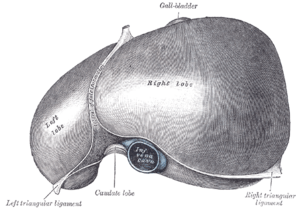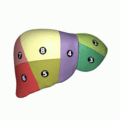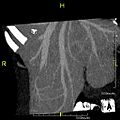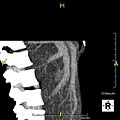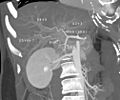Liver facts for kids
The liver is an organ in the abdomen. It is part of the gastrointestinal system. Sometimes people use hepar- or hepat- as a prefix when they talk about the liver. The liver is both the heaviest internal organ and the largest gland in the human body.
Contents
Structure
The liver is a dark reddish brown, wedge-shaped organ with two lobes of unequal size and shape. A human liver normally weighs approximately 1.5 kilograms (3.3 pounds) and has a width of about 15 centimetres (6 inches). There is considerable size variation between individuals, with the standard reference range for men being 970–1,860 grams (2.14–4.10 lb) and for women 600–1,770 g (1.32–3.90 lb). It is located in the right upper quadrant of the abdominal cavity, resting just below the diaphragm, to the right of the stomach, and overlying the gallbladder.
The liver is connected to two large blood vessels: the hepatic artery and the portal vein. The hepatic artery carries oxygen-rich blood from the aorta via the celiac trunk, whereas the portal vein carries blood rich in digested nutrients from the entire gastrointestinal tract and also from the spleen and pancreas. These blood vessels subdivide into small capillaries known as liver sinusoids, which then lead to hepatic lobules.
Hepatic lobules are the functional units of the liver. Each lobule is made up of millions of hepatic cells (hepatocytes), which are the basic metabolic cells.
Function
The liver does many important things in the body:
- The liver makes bile. This is a yellow-green liquid that goes into the small intestines to help digest the food we eat.
- The liver stores glucose when we eat and then puts the glucose into the blood when our blood glucose level goes down. This may happen when we have not eaten for a while.
- The liver takes protein and fat and turns it into glucose. This is important if we have no food to eat. We can use the fat we have saved, and make it into glucose to use.
- The liver also makes some fats and cholesterol.
- The liver metabolizes (breaks down) many things in the blood:
- hemoglobin
- proteins like enzymes, insulin, and serum amyloid a
- Ammonia
- toxins (substances that are poisons) and waste from the body
- The liver stores (keeps) vitamins and minerals.
- The liver makes many proteins:
- proteins that make your blood clot – called coagulation proteins.
- proteins like albumin
- In fetuses when they are very small, the liver makes red blood cells.
Liver diseases
There are many different liver diseases. Liver disease can make someone very sick because of all the important work the liver does. People who have bad liver disease usually die unless they can get a liver transplant. This is when the liver from someone who has just died is put in another person by surgery. Such surgeries are usually technically challenging but can be life-saving.
Symptoms of liver disease
The symptoms of liver disease happen because the liver does not do the work it should.
The liver cannot metabolize toxins and waste so these bad things stay in the blood longer. One thing that builds up is a substance called bilirubin. When red blood cells die, the hemoglobin in them leaks into the blood. The hemoglobin becomes bilirubin (a yellow substance that makes bile yellow). The liver takes the bilirubin out of the blood and puts it into the bile. The bile goes into the intestines and then goes out with the waste from your body. If the liver is hurt, it does not remove the bilirubin, so the bilirubin stays in the body. This makes the person's body look yellow and is known as jaundice. So yellow eyes and yellow skin are symptoms of liver disease.
Treatments for liver disease
Some liver diseases can be treated easily with medicine. Hemochromatosis is treated by taking blood from people every two months.
Some liver viruses can be stopped before they start. Two types of viral hepatitis can be stopped with an immunization. Hepatitis A and Hepatitis B can be prevented with a total of five shots in a person's life.
Some liver diseases can only be treated with liver transplant.
Food
The liver of mammals, fowl, and fish are commonly eaten as food by humans. Domestic pig, ox, lamb, calf, chicken, and goose livers are widely available from butchers and supermarkets.
Liver can be baked, boiled, broiled, fried, stir-fried, or eaten raw (asbeh nayeh or sawda naye in Lebanese cuisine, or liver sashimi in Japanese cuisine. In many preparations, pieces of liver are combined with pieces of meat or kidneys, like in the various forms of Middle Eastern mixed grill (e.g. meurav Yerushalmi). Well-known examples include liver pâté, foie gras, chopped liver, and leverpastej. Liver sausages such as Braunschweiger and liverwurst are also a valued meal. Liver sausages may also be used as spreads. A traditional South African delicacy, namely skilpadjies, is made of minced lamb's liver wrapped in netvet (caul fat), and grilled over an open fire.
Animal livers are rich in iron, vitamin A and vitamin B12, and cod liver oil is commonly used as a dietary supplement. Traditionally, some fish livers were valued as food, especially the stingray liver. It was used to prepare delicacies, such as poached skate liver on toast in England, as well as the beignets de foie de raie and foie de raie en croute in French cuisine.
Images for kids
-
Maksalaatikko, a Finnish liver casserole
See also
 In Spanish: Hígado para niños
In Spanish: Hígado para niños


